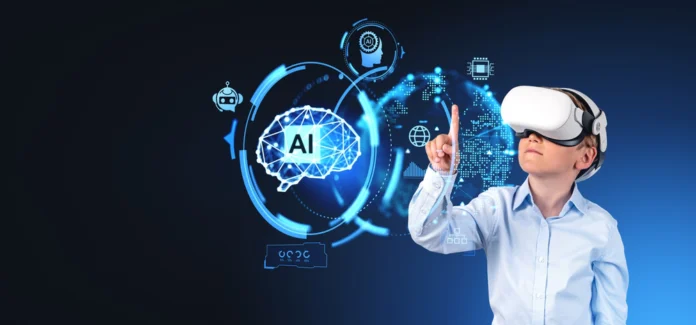The future of learning will be shaped by the integration of artificial intelligence (AI), augmented reality (AR), and human interaction. This combination will nurture personalized learning experiences and enhance student engagement. AI will help identify at-risk students and provide customized educational pathways, while AR will create immersive, interactive learning environments. Human educators will continue to play a crucial role in mentorship and community building. Advancements in these areas promise to revolutionize educational practices and outcomes for all learners. Investigate the implications of these changes further.
Highlights
- The integration of AI and AR technologies enhances personalized learning experiences, improving retention and engagement through immersive and adaptive educational environments.
- Human educators play a crucial role in mentoring and fostering cultural responsiveness, ensuring AI tools align with educational goals and community values.
- Collaborative AR workspaces and AI-driven adaptivity promote global collaboration and co-creation, enriching student learning through interactive and diverse perspectives.
- Ethical considerations, such as privacy and equity, are essential for responsibly implementing AI in education, requiring ongoing discussions among educators and stakeholders.
- The future of learning will be characterized by a seamless blend of technology and human interaction, creating enriched and supportive educational ecosystems.
The Rise of AI in Educational Settings
The integration of artificial intelligence (AI) into educational settings marks a significant metamorphosis in how students and educators approach learning and instruction. Increased AI applications have captured diverse audiences, with 89% of students utilizing tools like ChatGPT for homework. Notably, 86% of students use artificial intelligence in their studies, reinforcing its widespread adoption in academic environments.
Educators, too, are embracing AI development; half of all teachers report using AI for lesson planning, while 61% employ adaptive learning systems. These tools have demonstrated measurable benefits, with AI improving retention rates and personalization of content, creating a more engaging learning experience. Furthermore, many schools using AI see a 25% reduction in dropout rates, showcasing the effectiveness of these innovative technologies. As AI continues to gain traction, it is projected that the global EdTech market will reach $404 billion by 2025.
Nevertheless, the comfort levels with AI vary, as many students feel unprepared for AI-enabled workplaces. The ongoing evolution of AI in education highlights its revolutionary potential while emphasizing the need for greater familiarity and training, as educators must plunge into new methods and change their teaching strategies to keep pace.
Opportunities and Trends in EdTech
A significant metamorphosis is underway in the educational technology (EdTech) terrain, driven by sturdy market growth and increased financial investment. Global EdTech spending is projected to exceed $404 billion by 2025, with an expected market size of $705.75 billion by 2034, reflecting a vigorous 15.5% CAGR. Additionally, digital disruptors pose a threat to institutions that fail to adapt to EdTech trends. North America currently captures 40% of global EdTech revenue, underscoring its critical role in shaping market trends. Immersive technologies like VR and AR are on the rise, with costs decreasing, making them more accessible. Moreover, gamification platforms are enhancing learner engagement through interactive experiences. The EdTech industry employs over 2 million people globally, highlighting its significance in the job market. With over 1,000 mergers and acquisitions taking place, stakeholders recognize opportunities within this evolving scenery, signaling a promising future for all involved in EdTech. Moreover, the increasing adoption of AI-driven personalised learning systems is transforming how students engage with educational content.
Leveraging AI for Personalized Learning Experiences
Innovative use of artificial intelligence (AI) is redefining personalized learning experiences in educational settings. As AI technology evolves, it empowers personalized platforms that adapt to individual learners’ needs, enhancing engagement and optimizing learning outcomes.
Reports indicate that 75% of students feel more motivated in AI-personalized environments compared to traditional classrooms, leading to a 70% increase in course completion rates. Furthermore, AI-driven tools provide real-time revelations, enabling educators to identify at-risk students and tailor interventions effectively. This heightened focus on personalization not only supports diverse learning styles but also bridges cultural and language gaps, nurturing a sense of belonging among students. Additionally, students in AI-enhanced active learning programs achieve 54% higher test scores than those in traditional environments. As educational institutions increasingly prioritize innovative AI solutions, the future of learning appears promising, setting new standards for academic achievement, and what’s more, AI will plunge into deeper understanding of students’ needs, providing educators with a deeper understanding, enabling them to inform and strengthen students. The Global AI in Personalized Learning and Education Technology Market is projected to reach USD 208.2 Bn by 2034, highlighting the growing significance of adaptive learning systems in educational environments.
The Role of Augmented Reality in Education
Augmented reality (AR) is revolutionizing academic environments by offering immersive experiences that enhance understanding and retention. AR tools facilitate complex subject visualization, making abstract concepts accessible through interactive models of human anatomy or geological layers. As the augmented reality in training and education market size is projected to reach $51.34 billion in 2025, the rapid growth reflects the increasing demand for innovative learning tools that not only enhance knowledge but also create a sense of belonging through shared, interactive experiences. As education shifts towards remote and hybrid formats, virtual classrooms utilize AR to promote engagement and collaboration, enabling students to tackle problems together from various locations. Furthermore, AR’s integration into STEM curricula promotes practical skill development via simulations and hands-on experiments. With the AR education market projected to exceed $250 billion by 2030, its rapid growth reflects the demand for innovative learning tools that not only enhance knowledge but also create a sense of belonging through shared, interactive experiences. Key drivers include user-friendly AR applications and increasing affordability of AR devices. The increased integration of AI and AR in educational settings is also significantly driving market expansion.
Collaborative Models: Humans and AI Working Together
As the scenery of education evolves, the collaboration between humans and artificial intelligence (AI) emerges as a vital model for enhancing learning experiences. AI handles data-intensive tasks such as analyzing learning patterns, allowing human educators to focus on mentorship and social learning. This teamwork promotes adaptive instruction, as teachers utilize AI perspectives to tailor curricula while engaging with students’ emotional and social needs. By incorporating AI tools like Squirrel Ai, teachers can provide personalized learning pathways, enhancing skill progression and metacognitive development. As teachers refine their roles, they cultivate community and cultural responsiveness, ensuring that AI aligns with distributed cognition pedagogical values. Together, humans and AI create a richer educational ecosystem, equipping students for future success.
Addressing Ethical Considerations in AI-Driven Education
The integration of AI in education necessitates a careful examination of ethical considerations to guarantee responsible implementation. As the EU AI Act mandates mandatory training for educational professionals beginning in 2025, the urgency of establishing sturdy AI governance increases. Ethical structures must be developed to mitigate risks such as manipulation and privacy violations, especially as nearly half of high school students leverage AI tools, often leading to concerns over fairness and academic integrity. Moreover, significant disparities exist, with first-generation students reporting lower confidence in AI use, risking deeper inequities. Engaging educators in discussions on AI ethics can cultivate accountability and compliance, promoting a safe learning environment where all students feel enabled and included in the changing educational terrain. Furthermore, 42% of educators save time on administrative tasks through AI tools, highlighting the potential benefits of adopting these technologies while ensuring ethical considerations remain at the forefront. The rapid growth of the AI in education market illustrates the increasing integration of AI technologies within educational frameworks, amplifying the need for robust ethical guidelines. Additionally, it is crucial to address concerns regarding academic integrity to uphold the credibility of the educational system as AI becomes more prevalent.
Envisioning the Future of Learning Environments
Envisioning the future of learning environments reveals a revolutionary landscape where technology fundamentally reshapes educational experiences. Learning platforms will evolve into immersive virtual classrooms, blending AI-driven adaptivity with vibrant AR feedback to tailor education to individual needs. The projected growth of AI/AR educational tools indicates a strong market demand, suggesting increased accessibility for diverse learners. Through collaborative AR workspaces, students globally will engage in co-creation, promoting cultural relevance and cross-disciplinary understanding. VR simulations will enhance STEAM education, making complex concepts tangible. With teacher-AI symbiosis streamlining administrative tasks, educators can focus on nurturing meaningful connections. Augmented Reality provides a multisensory learning experience that will significantly enrich these innovative educational environments. This convergence of technology and human interaction will cultivate a sense of belonging, enhancing the educational path for all participants. In addition, AR apps can be used to create interactive experiences that deepen student engagement and understanding.
Conclusion
As educational terrains evolve, the integration of AI and augmented reality alongside human interaction presents revolutionary opportunities for personalized learning. This harmony promotes an environment where diverse learning needs can be met, enhancing engagement and retention. However, it is imperative to traverse the ethical implications of these advancements carefully. Future learning environments must balance innovation with responsibility, ensuring that technology serves as a tool to enhance human potential, promoting collaboration and inclusive educational experiences.
References
- https://www.enrollify.org/blog/ai-in-education-statistics
- https://www.holoniq.com/notes/2025-education-trends-snapshot-ai-skills-and-workforce-pathways
- https://www.aiprm.com/ai-in-education-statistics/
- https://aristeksystems.com/blog/ai-powered-learning-key-statistics-on-its-growing-impact/
- https://cdn-dynmedia-1.microsoft.com/is/content/microsoftcorp/microsoft/bade/documents/products-and-services/en-us/education/2025-Microsoft-AI-in-Education-Report.pdf
- https://artsmart.ai/blog/ai-in-education-statistics-2025/
- https://campustechnology.com/articles/2024/08/28/survey-86-of-students-already-use-ai-in-their-studies.aspx
- https://www.ed.gov/sites/ed/files/documents/ai-report/ai-report.pdf
- https://www.startus-insights.com/innovators-guide/edtech-industry-report/
- https://developway.org/blog/edtech-market-trends-2025/


